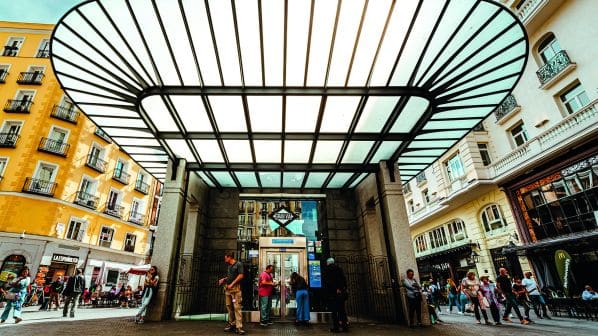IN May this year the International Association of Public Transport (UITP) published its report How to Make Stations Lively Hubs for Both Citizens and Public Transport Users: Solutions. The report has been produced within the framework of the Stations of the Future project, led by UITP in partnership with lift and escalator manufacturer Kone.
Compilation involved collecting examples of best practice from around the world, gathered online and at workshops and “brainstorming sessions” held at locations including Singapore, Jacksonville and Delhi. Pointing to best practice along the way, the report takes a step-by-step journey through the station to highlight areas in each phase of the process where improvements can be made, both in new-build projects and at existing stations, to meet changing passenger needs. These solutions fall into the categories of technology, infrastructure and management, and are considered from the perspective of public transport users as well as the operators of the services and stations that they use.
“Our whole journey experience in public transport is defined by the experience we have at stations, how they are designed, how clearly we find our way, what the quality of the architecture is.”
David Vitezy, CEO and senior public transport expert at Hungarian consultancy Transport Research Budapest, and a former CEO of Budapest public transport authority BKK
“This handbook is about how to design stations,” said Mr David Vitezy, CEO and senior public transport expert at Hungarian consultancy Transport Research Budapest, and a former CEO of Budapest public transport authority BKK. Chairing a session on Stations of the Future at the UITP Global Public Transport Summit in Barcelona on June 6, Vitezy stressed the need to place the passenger at the heart of the design process.
“Our whole journey experience in public transport is defined by the experience we have at stations, how they are designed, how clearly we find our way, what the quality of the architecture is,” Vitezy said.
“The station is the face of our public transport systems, both rail and metros, and I think putting the attention needed in designing and managing them is really very important to attract more customers to our systems to fully recover after the pandemic.”
The study has aimed to identify the needs and expectations of different groups of passengers, and explore how stations can be made more welcoming and inclusive for all. The report notes, however, that the limitations of the study include the lack of direct involvement of passengers or station users.
To determine user requirements, two contrasting demographic groups were chosen, Generation Z, or those born between 1997 and 2012, and “representatives of the Silver Economy.” They were selected in recognition of the fact that user expectations change with age and to highlight the importance of catering to different, yet significant, segments of the customer base.
Key challenges identified during the analysis of user needs included differences in speed of movement through the station as well as digital proficiency and autonomy. The report says that while some passengers feel comfortable using their mobile phones to plan their journeys and find their way around, and also prefer self-service solutions, others prefer human contact when seeking information and assistance.
The way in
The report’s journey through the station starts with Entrance, considering how to make it easier for passengers to find their way when arriving at the gateway to a public transport network.
To better manage and segregate people flows, recommendations here include dedicated entrances and exits, as well as dedicated entrances from bicycle parking areas. The report says that at least one entrance - and preferably all gateways to the station - should be fully accessible to passengers with reduced mobility (PRM), citing here as best practice Madrid Metro’s Accessibility and Inclusion Plan that has seen lifts and other complementary measures installed at stations.
Alongside such infrastructure improvements, one management solution recommended here is to alert passengers in advance if station equipment such as lifts and escalators, or passenger facilities such as toilets, are out of service. This could be provided via mobile phone apps or other online journey planners, with the websites of both RATP in Paris and WMATA in Washington DC now providing information on the availability of lifts and escalators. As Mr Cãlin Hera, Kone’s business development manager for the public transport sector, pointed out in Barcelona, “nowadays, equipment like lifts and escalators can be connected to the internet. Therefore this information is available in real time for the system operator to provide it to the people who need it.”
The threshold crossed, the report goes on to consider the Concourse/Ticket Hall in its next section. To help passengers find their way around, one recommendation is to install projectors to display information in either a static or animated way, which is more attention-grabbing than conventional floor markings and has the advantage of not causing any physical obstruction to passenger flows. Another management change is to provide an indication of the walking time and distance to the platform. Here, the report also notes that train departure times do not need to be displayed in the same way across the entire station, as at some locations it may be appropriate to not display information about departures when it is no longer possible to reach the platform without rushing.
Ticketing and customer assistance
To avoid queues at ticket offices or ticket vending machines (TVMs), UITP recommends that operators provide multiple payment options, citing as best practice payment using QR codes on mobile phones at MTR of Hong Kong, and the first deployment of contactless payment on a metro system in Brazil by MetrôRio of Rio de Janeiro. Considering the TVMs themselves, the report says that they should be intuitive for passengers to use, with readable displays and clear and concise instructions in a selection of languages. This would reduce frustration, shorten queues and make reliance on support staff unnecessary. If no staff are present, the TVM should be equipped to enable the user to seek remote assistance.
While some passengers are happy to use digital tools, others need or prefer more personalised assistance involving human interaction. The report therefore recommends that customer service centres should be accessible to the maximum number of users at major hubs.
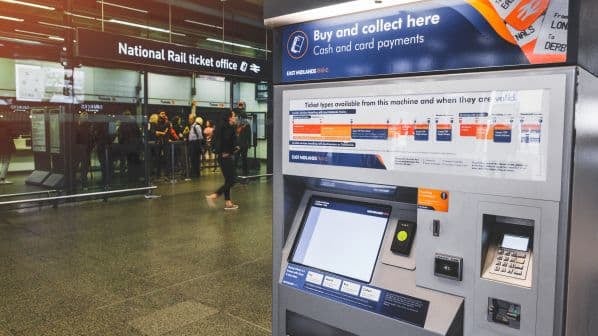
As best practice, UITP cites the use of stations on the SMRT network in Singapore as “Go To Points” for people with dementia, providing assistance to enable them to return home safely. Volunteers or staff ambassadors could provide support for those needing more help, and the report also recommends making trained instructors available to help passengers understand how to use journey planners, ticketing apps and other digital tools.
Turning to waiting areas, passenger wellbeing here could be improved by the creation of silent zones, and the provision of drinking water or entertainment such as TV or reading matter.
Recommended infrastructure design enhancements for the Concourse/Ticket Hall area include clear lines of sight enabling passengers to see exactly where they need to go, and providing more natural light and green space to create a more calming and inviting atmosphere. Charging points for mobile phones and other devices should be provided in the station, and a strong mobile phone signal should be available to enable passengers to work and access digital travel tools.
Third-party services that could be provided include co-working areas and parcel collection points, as well as retail outlets, which will enable operators to take advantage of their city centre location and generate extra revenue.
Changing zones
The next section of the UITP report considers Ticket Gates, or more specifically the boundary that only fare-paying passengers can cross.
Especially at stations without ticket gates, this boundary between public space and the fare area should be made highly visible and clear to all users, in order to avoid confusion or any dispute. Gate lines should be staffed, as a human presence to provide assistance here plays a crucial role in reducing queues and congestion, according to the report. There should always be one wide gate available for passengers in wheelchairs, pushing a buggy or travelling with bulky luggage. The gate speed can be varied to assist with managing passenger flows, for example by helping to reduce congestion by increasing the length of time it takes to pass through the gate.
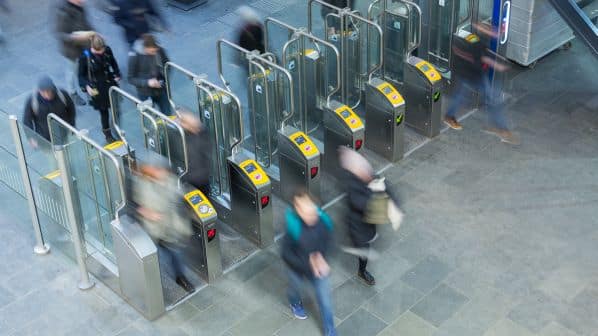
Beyond the gateline, the organisation of passenger flows is considered in the Corridors, Stairs, Elevators, Escalators section. Walking directions should be defined in order to reduce points of conflict and provide a smoother journey for all. Physical infrastructure, floor markings or lights can be used for this purpose, as well as colour coding of floor and wall markings and signage to guide users, as colour codes such as for individual metro lines are usually more readily understood than text. To remove a potential obstacle to smooth flows of large numbers of people, the report also recommends installing bollards at strategic locations to prevent passengers with bulky luggage or luggage trolleys from passing through, instead providing them with an alternative route if the items in question are allowed to be taken onboard. Similarly, fast and slow lanes are proposed for station corridors, enabling slower users to proceed at their own pace.
Turning to vertical circulation, the report says that users should be made aware of good habits for stair and escalator use in the interests of passenger safety, either by using nudging techniques or more explicit measures. Dynamic lighting can indicate where passengers should and should not stand on an escalator and when the end of the escalator is approaching. At the UITP summit in Barcelona, Hera described how using different colours on escalator step treads had enabled social distancing to be maintained during the pandemic, while Kone is now piloting video monitoring combined with AI to detect incidents in real time and take appropriate action. This might include audible warnings, slowing the escalator or even bringing it to a stop. For shorter vertical distances, potential escalator congestion could be averted by directing passengers to stairs as an alternative, possibly combined with campaigns to promote stair use as part of a healthier lifestyle.
To enable passengers to feel in control and reduce frustration, waiting times for lifts should be displayed or, if on a fixed service such as stopping at all floors, an indication provided of which lift will be the next to arrive. As well as enabling incidents and faults to be monitored in real time, connecting station equipment to the internet enables lifts to automatically arrive when passenger flows are heavy or when a train arrives in the station.
On the platform
The Platform section of the report considers the interface between the station and the train, and says that this should be as safe and smooth to negotiate as possible. To ensure even distribution of passengers, floor markings should be used to direct users away from the entrance to the platform, which might also be achieved with the “nudge” of placing services or retail facilities further away from the entrance. Passengers can be directed to less busy sections of the train by harnessing onboard load monitoring or passenger-counting data to provide real-time information on train occupancy.
UITP’s example of best practice here is the Hector system developed by French National Railways (SNCF), which is now being rolled out across the Paris suburban network after a successful trial on Line H. This uses data gathered by infrared passenger-counting sensors located above the doors to display train occupancy in real time at stations. At quieter times, it can help passengers to be closer to one another if they have personal safety concerns about travelling alone. Station displays and timetables should also indicate train composition and the location of onboard facilities, the report says, with platforms marked to indicate the position of specific cars within the train.
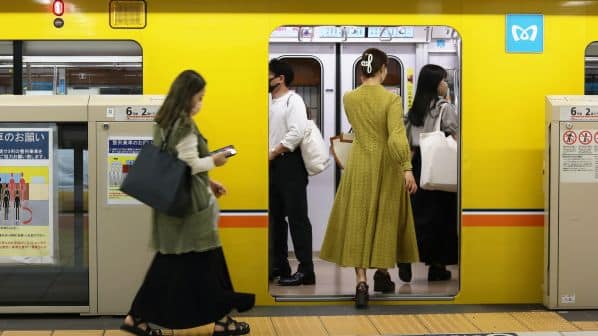
To improve safety at the interface between the station and the train, the report recommends the installation of platform screen doors, which offer the additional benefits of reducing train noise and making station ventilation and air-conditioning easier to control. Sensors or CCTV cameras to detect passengers falling onto the track are also suggested, as part of systems that would automatically generate an alarm, bring trains to stand and stop any other appropriate equipment. Help points should be installed to enable passengers to contact staff in the event of an emergency or for other assistance, and the report says that holograms and robots could provide a more interactive or intuitive alternative to fixed help points.
The use of robots to provide passenger assistance and undertake other tasks as part of a wider digital transformation programme is now being tested by East Japan Railway (JR East) under its own Station of the Future project, as Mr Ippei Nemoto, a researcher at JR East’s Frontier Service Development Lab told the UITP summit in Barcelona. “The concept of the Station of the Future is to transform the role of stations from a hub for transport to a hub for daily life,” he said. “By providing enhanced guidance, we can provide peace of mind to our customers.”
A prototype autonomous robot has been deployed at Takanawa Gateway station, whose movements and functions are guided by passenger congestion data gathered using webcams and 70 laser sensors, Nemoto explained. When the level of congestion is low, the robot moves freely around the concourse at speeds of up to 3km/h, undertaking duties such as cleaning the floor or inspecting it for defects that could cause passengers to trip and fall. A medium level of congestion sees the robot operate in stop/go mode, patrolling and providing guidance at up to 2km/h. At times of high congestion when it would be hard to move, the robot stands still and performs what Nemoto described as “sentry duty.”
JR East is also testing AI communications robots to provide passengers with assistance and advice on journey planning via station information points and mobile apps. One problem here is that the current systems are not linked in order to provide a common set of responses to the questions most frequently asked by passengers, and Nemoto said that JR East’s goal was to bring the data together in order to automate the process. A communications robot would be able to contact a physical member of staff if it could not provide the necessary information, and the response used to modify the information supplied in future. Analysis of the questions asked by customers would also enable JR East to better understand their needs.
Connecting at the exit
The final section of the report’s journey through the station of the future covers the Exit, which it points out is the beginning of another stage in the passenger’s journey, be it a short walk to their final destination or connecting with another service or mode that may take them much further. Providing information on connecting services as well as on what can be found in the immediate vicinity of the station is therefore essential, the report says. Signage directing passengers to connecting or alternative modes should be visible at strategic locations both inside and outside the station, with real-time departure information provided for connecting services.
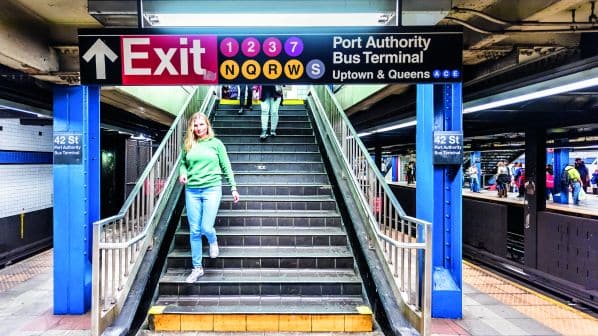
In providing local maps and other depictions of the area, the station’s surroundings should be visually represented in a way that is understandable to all, with signs and other wayfinding indicating local landmarks rather than street or area names that the passenger might not be familiar with, particularly if they are a first-time or infrequent visitor to the city in question.
Good design from first principles
THE need for good design that meets passenger needs is often highlighted in the stations report, and some insights into how to achieve this from first principles were offered at the UITP summit in Barcelona by Ms Zoe Green, principal designer and director at Meld Studios in Sydney, Australia.
“Meld Studios partners with organisations to solve complex problems using a human-centred design approach which, simply put, is putting those who are involved in the change at the centre of the change,” she explained.
The company’s preferred solution to achieving a user-friendly design for anything from a push button to a new train or even a major transport interchange is prototyping, presenting future users with a design concept and asking them for feedback based on their own personal experience. “We let them tell us the truth,” Green said. “The more you can test with customers, the more data you can gather, developing more confidence in the thing that you’re putting out into the world, ensuring that it’s not just an assumed need, it’s an actual need.”
Prototyping can be done “at any scale, at any fidelity, and at any budget,” according to Green. She defined fidelity as “the exactness of a thing,” and low-fidelity prototyping could involve presenting the future user with printed 2D renderings that are then discussed, annotated and drawn on. A slightly higher degree might involve roleplay, which has seen future passengers walking around mock-ups of future interchanges. “They were able to reflect in real time, telling us what they needed in those situations,” Green said.
“When we are experts in a field, it is really easy to forget that we don’t know what we don’t know,”
Ms Zoe Green, principal designer and director at Meld Studios in Sydney, Australia
The next step up is to use virtual reality (VR), which offers exciting possibilities and is “very sexy at the moment,” Green says.
“It’s about translating these CAD models into VR reality models where customers can put the headset on and physically almost walk through these stations. We attempted this with five stations and over 300 customers, and they were able to interact with the station, the precinct and the interchange step by step. The great thing about VR is it helps to give that sense of scale that a 2D piece of paper can’t really provide.”
Even closer to the real thing, an example of high-fidelity prototyping is to build a full-scale mock-up of a new vehicle. “We asked 80 customers to walk through these different scenarios, boarding and alighting, and then tell us what was working and what wasn’t,” Green said.
“There’s a temptation to spend more, to start with a higher-fidelity near-perfect model of what we think needs to be true, with the assumption that that’s the only way to gather valuable insights,” Green pointed out. “But what I’d argue and actually recommend is starting quite the opposite way with a low-fidelity model. And using raw customer insight to continuously iterate feedback into the design. We can then test it again and again, building up to these high-fidelity models.”
“When we are experts in a field, it is really easy to forget that we don’t know what we don’t know,” Green said. “And we are not the typical transport user which we are designing for. There’s always something new to learn, especially from human experiences that are very different from your own.” To ensure that a wide range of passenger experience informs its prototyping work, Meld Studios takes a different approach.
“We flip the typical recruitment models to make sure that we’re asking a really diverse and inclusive group of people so that we’re not just getting the same nine to five commuters that generally find commuting reasonably straightforward,” she says.
In conclusion, Green quoted the great American architect and designer Frank Lloyd Wright who said “you can use an eraser on the drafting table or a sledge hammer on the construction site.” Green’s own advice was “test early and test often. It removes risk for projects before it is too late.”
